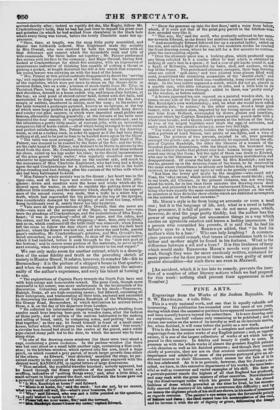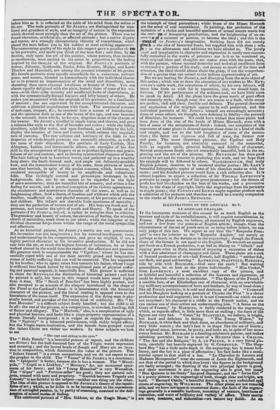FINE ARTS.
Engravings from the Works of Sir Joshua Reynolds. By S. W. REYNOLDS. 4 vols. folio. This is a truly national work, and one that is equally valuable and interesting. Its publication has extended over the space of ten years, dunng which time the successive portions have appeared unostentatiously, and been scarcely known beyond the subscribers. It is now drawing near to completion, one-half volume only remaining to be published ; and, it claims our notice on the score of its novelty as well as its intrinsic merits, for, when finished, it will come before the public as a new work. This is the first instance we know of a complete and uniform series of engravings from the entire works of any English painter ; and, as regards extent, it is one of the largest collections of works of art which has ap- peared in this country. In fidelity and beauty it yields to none: It presents us with the whole works of almost the greatest English painter —his sketches as well as his finished pictures ; and though they consist chiefly of portraits, they are not on that account uninteresting, as the importance and celebrity of most of the persons portrayed give an ad- ditional interest to their likenesses, which dtones for the lack of it in the less celebrated. As it is in portrait, however, that Sir JOSHUA ex- celled, we have, in this extensive department of his works, the most beau. tiful as well as numerous and varied examples of his skill. His fame as a portrait-painter stands the highest of all that England has produced, and may rank with the great masters of other countries. Notwithstand- ing the disadvantages under which his genius laboured in the absurd fashions of dress which prevailed at the time he lived, he has success- fully exerted the masteryof his talent to overcome this difficulty ; and by no means the slightest proofs of his skill are shown in his mode of treatment as regards costume. The painter's eye seizes upon the favourable points of feature and chess; the ideal enters into his contemplation of the real, and he invests it with the air of dignity or grace, delineating the image his eye. The male portraits of Sir. JOSHUA are distinguished for man- liness and grandeur of style, and an integrity of nature in the expression which showed more strongly than the art of the picture. There was no forced elevation, artificialmr, or affected attitude ; but a native dignity aud repose, or a strongly characteristic identity of resemblance, which placed the man before you in his noblest or most striking appearance The unassuming quality of his style in this respect gave a peculiar ch:
to his portraits, and made you think of the man first ; and then, by reu flection, only upon the art of the painter, whose powers, thus recalled to recollection, were exalted in the mind in proportion to the feeling
inspired by the thought of the original Sir JOSHUA'S portraits of Sterne, Johnson, Goldsmith, Burke, John Hunter, Mudge, and Lords
Thurlow and Mansfield, are among the greatest triumphs of his genius. His female portraits were equally remarkable for a sweetness, naïveté, grace, and nature, blended so harmoniously with the individual charac- ter as to present an impersonation of the -mind and disposition more charming than mere external loveliness or beauty of form. 'Von are almost equally delighted with the plain, homely faces of some of his wo- men—with their calm serenity and unaffected looks of cheerfulness, as with the symmetrically-formed features and lofty beauty of others. He makes you acquainted with the originals of his portraits, by a familiarity of manner ; you are captivated by the unsophisticated character, and cultivate a pictorial acquaintance with them. The unnatural costume of mob-caps, toupees &c., he converts into a means of introdaction ; and the spectator feels as one of the beaux of the age, and sees beauties
in the uncouth dress tallish, to his eye, disguises none of the charms of the wearer. Sir JOSHUA revelled in ample trains and sleeves, and gave
a sultana-like style to the flow of brocades and satins ; while the falling shoulders, sylph-like waist, and open forehead, nut hidden by the hair, display the beauties of form and feature, which redeem the ungainli- ness of costume. The easy softness and intricacy of the folds in his draperies of whole-length portraits are especially admirable, as well as the taste of their disposition. His portraits of Lady Carlisle, Mrs. Abington Lesbia, and innumerable others, are examples of his tine skill in the arrangement of drapery so as to produce lightness and grace- fulness of air and contour, and to develop symmetrical elegance of form. The hair folding back in luxuriant waves, and gathered up in a wealthy heap above the finely-formed neck, and ample yet delicately-moulded bust, and the transcendent beauty of his arms, form pictures of loveli- ness that bewitch, in spite of the quaint costume, which, however, is rendered susceptible of beauty in its amplitude and voluminous folds. The strikingly natural and picturesque landscapes in his
backgrounds, also, are by no means to be regarded in the light
of mere accessories; they are beautiful bits of scenery, and evince a fine feeling for nature, and a poetical conception of its various appearances ; the consistency and appropriate character of the scene, as well as its heightening effect, lend a charm of freedom and wildness which aids the familiar, unaffected air, and playful manner, of his portraits of women and children. His infants are cherubic little specimens of mortality ; they are the perfection of nature and of art. His boys are frank and in. genuous, and breathe the spirit of youth and liberty. To speak of the
portraits of Sir JOSHUA, indeed, is rather to eulogize than to criticize. The grandeur and beauty of nature, the elevation of feeling, the winning charm of amiability, exalt them to the ideal; while the integrity of in- dividual character keeps them within the range of the social sympathies and affections.
As an historical painter, Sir Joshua's merits are not pre-eminent. His invention was not imaginative ; but he exerted intelligence, taste, and understanding in his compositions, and gave an original, if no a highly poetical character to his inventive productions. If he did not soar into the air, or reach the highest heaven of invention, he at least walked abroad in the world into the realm of the affections and passions. His greatest work is unquestionably the " Ugolino," where he has suc- cessfully coped with one of the most terribly grand and imaginative scenes of bodily suffering that can well be conceived. The boy supported by his brother, who in agony raises him towards his father, whose visage is stiffened into blank horror by the complicated pain of physical suffer- ing and paternal anguish, is beautifully fine. This picture is sufficient
to claim for REYNOLDS the distinction of historical painter • and had he painted it only, his fame in this respect would have stood higher
than it does. The "Death of Beaufort" has been highly praised, and also excepted to on account of the allegory introduced in the shape of the Fiend at the Cardinal's head: it is inconsistent with the historical character of the picture, and the literal reading is opposed even to the literalness of the scene itself. The expression of the dying man is phy- sically horrid, and partakes of the lowest kind of sublimity. His "In- fant Hercules" is a difficult subject finely handled ; but the child is all
in all : the rest of the picture, as a composition, is crowded, bustling, full of flutter and allegory. The "Macbeth," also, is a complication of ugly
and physical horrors, and looks like a stage-property representation of a
dream literally interpreted : it is vulgar as regards the imagination. The "Nativity" is a laboured performance, with richly bright effect; but the Virgin wants inspiration, and the female faces grouped round the infant Christ are rather too modern. In these subjects we look to see
"The rapt soul sitting in the eyes."
The "Holy Family" is a beautiful picture of repose, and the children are divine; but the half-featured face of the Virgin wants expression Isnd meaning; and the bowed heads of Joseph and Mary are an itera- tion in composition, which diminishes the value of the picture. The "Infant Samuel" is a sweet composition, and we do not expect to see the prophet in the child. The "Venus" of Sir Joshua is a courtezan;
the Iphigenia" is better, because she is but a woman. The " Musci- pula," "Cupid as a Linkboy," "Mercury," &c. are mannered speci-
mens of his fancy; and his "Young Hannibal" is very Westallish.
The "Gipsy" and "Fortune-teller" are good; they are natural sub- jects, treated with taste and propriety. "Garrick between Tragedy and
Comedy" is too faithful to the subject—neither one thing nor the other. .The idea of this picture is opposed to Sir Joshua's theory of the capabi- lities of art;. which, as he holds it to be incompetent to the representa- _Con of an:tingled passion, is, by parity of reasoning, unsuited to the deli- imation of mixed modes of feeling. The celebrated portrait of "Mrs. Siddons, as the Tragic Muse," is But we are leaving Sir JosnuA, and diverging from the main object of this notice ; which was to draw the attention of our readers to Mr. HEY. Isro LDS'S noble work, the completion of which, by his own labours, will leave him little to wish for in reputation, and, we should hope, in fortune. Of his performance of the arduous task, we have little room to speak in detail. All the plates have the great merit of good effect and masterly style ; though some few are coarse to a fault, while many are perfect, rich and clear, forcible and delicate. The general character and expression of the originals appear to be well preserved, and the individual portraits of Sir Josnua himself are exceedingly accurate; those of some others, we thought, were deficient in fidelity—the portrait of Sheridan, for instance. We could have wished that more plates had been done of the size of the heads of Misses Horneck, even with loss of some of the minuteness of finish : indeed, our complaint of the coarseness of some plates is directed against those done in a kind of chalk and stipple, and not to the bold roughness of some of the mezzo. tints ; the latter are vigorous and full of tone, the former raur and poor. The more important pictures, the tigolino and Holy Family, for instance, are admirably executed in the mezzotint, both as regards spirit, pictorial feeling, and fidelity of character. Several anonymous heads also are remarkably beautiful, both in the en- graving and the art of the pictures. Mr. REYNOLDS has done good service to art and its votaries in producing this work, and we hope that his example will be followed by others. GAINSBOROUGH, that truly English painter, deserves to be rendered similar justice : Mr. LANE'S beautiful lithographic copies of some of his sketches make us wish for more ; and his finished pictures would form a rich collection also. It is almost hopeless to expect a collection of Sir THOMAS LAWRENCE'S portraits to range with this of his great predecessor ; for the demon of profit has laid his clutches on the best of his works, and a preventive duty, in the shape of copyright, limits the engravings froth his portraits to single plates ; else Co 'isms and Lewis might together produce such a collection of his pictures and sketches as would be a worthy companion to the works of Sir JOSHUA REYNOLDS.



























 Previous page
Previous page